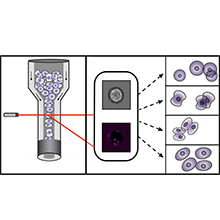With the right algorithms: optimizing cell cycle analysis

Cell cycle phases are assigned to bright and dark field images from imaging flow cytometry by using machine learning algorithms.
So far fluorescent stains have been used to assign cells to their cell cycle phase. These chemicals damage the cells and may distort the results. Scientists of the Helmholtz Zentrum München in collaboration with the Broad Institute of MIT and Harvard, Swansea University, Newcastle University and The Francis Crick Institute have now found an alternative.
„We used two generally neglected data sources: the bright and the darkfield images“ says Thomas Blasi, PhD student at the ICB and first author of the publication. „We could use the information in these data for machine learning“. This approach makes it possible to not only classify cells, but also to digitally sort them with a high level of specificity. Based on these findings the Broad Institute and the Helmholtz Zentrum München also filed a provisional patent application.
„Computer-based classification of cells based on large population of cell images opens up new perspectives. This approach could also be used in many different contexts, not only for cell cycle analysis“, adds Prof. Dr. Dr. Fabian Theis, head of the ICB.
Further Information
Original publication:
Blasi T. et al. (2016). Label-free cell cycle analysis for high-throughput imaging flow cytometry. Nature Communications.
DOI: 10:1038/ncomms10256 (open access).
As German Research Center for Environmental Health, Helmholtz Zentrum München pursues the goal of developing personalized medical approaches for the prevention and therapy of major common diseases such as diabetes mellitus and lung diseases. To achieve this, it investigates the interaction of genetics, environmental factors and lifestyle. The Helmholtz Zentrum München has about 2,300 staff members and is headquartered in Neuherberg in the north of Munich. Helmholtz Zentrum München is a member of the Helmholtz Association, a community of 18 scientific-technical and medical-biological research centers with a total of about 37,000 staff members. http://www.helmholtz-muenchen.de
The Institute of Computational Biology (ICB) develops and applies methods for the model-based description of biological systems, using a data-driven approach by integrating information on multiple scales ranging from single-cell time series to large-scale omics. Given the fast technological advances in molecular biology, the aim is to provide and collaboratively apply innovative tools with experimental groups in order to jointly advance the understanding and treatment of common human diseases. http://www.helmholtz-muenchen.de/icb
Media Contact
All latest news from the category: Life Sciences and Chemistry
Articles and reports from the Life Sciences and chemistry area deal with applied and basic research into modern biology, chemistry and human medicine.
Valuable information can be found on a range of life sciences fields including bacteriology, biochemistry, bionics, bioinformatics, biophysics, biotechnology, genetics, geobotany, human biology, marine biology, microbiology, molecular biology, cellular biology, zoology, bioinorganic chemistry, microchemistry and environmental chemistry.
Newest articles

A ‘language’ for ML models to predict nanopore properties
A large number of 2D materials like graphene can have nanopores – small holes formed by missing atoms through which foreign substances can pass. The properties of these nanopores dictate many…

Clinically validated, wearable ultrasound patch
… for continuous blood pressure monitoring. A team of researchers at the University of California San Diego has developed a new and improved wearable ultrasound patch for continuous and noninvasive…

A new puzzle piece for string theory research
Dr. Ksenia Fedosova from the Cluster of Excellence Mathematics Münster, along with an international research team, has proven a conjecture in string theory that physicists had proposed regarding certain equations….



